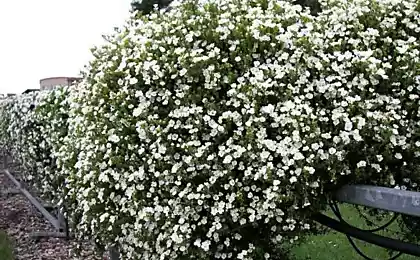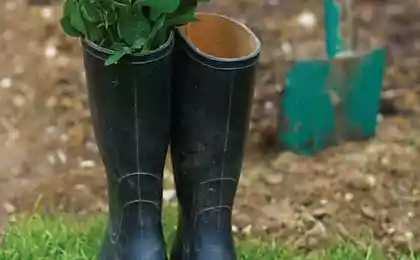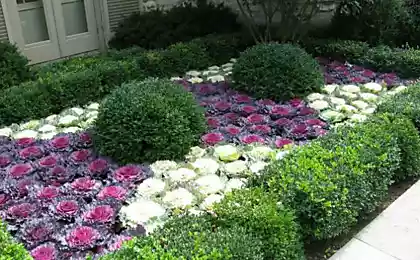609
How to care for chrysanthemums
Grow and care for chrysanthemums.
Flowering chrysanthemums – a real decoration of our gardens in autumn. This bright and generous gift of nature with sagebrush tart flavor like sent us to extend summer days...
History and types of chrysanthemums.
The birthplace of chrysanthemums is Asia. In Europe chrysanthemums was in the middle of the 18th century, but their activity is spread across the continent began almost a century later – in the early 19th century. In Russia, production of ornamental plants began in the 40-50-ies of the last century.
There is a perception that the diversity of chrysanthemum called the "garden" or Chrysanthemum hortorum occurred by crossing two species native to China and Japan – chrysanthemum grandiflorum or Chrys. morifoolium and small-flowered chrysanthemum, or Chrys. indicum.
Chrysanthemum in a biological concept is a genus of annual and perennial herbaceous plants of the family Compositae or Asteraceae, with up to 29 species and grows not only in Asia, but in temperate and Northern latitudes of the globe.
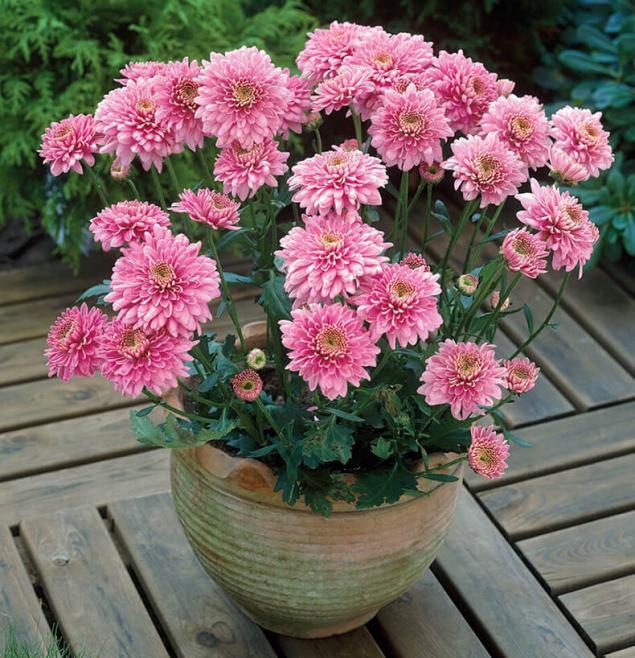
Perennial chrysanthemums.
Among small-flowered chrysanthemums isolated group of so-called Korean chrysanthemums or Ch. coreanum, install a separate species which have not yet succeeded. It is also unclear of their origin, therefore, the definition of "Korean" should be considered conditional. In Amateur gardening this kind of chrysanthemum the most popular, that Korean chrysanthemums decorate gardens in many suburban areas.
Korean chrysanthemum is relatively resistant to low temperatures, this feature allows the winter most varieties of chrysanthemums outdoors in regions with cold winters. In addition, these flowers are famous for abundant flowering and therefore are widely used in ornamental horticulture.
What are and when to bloom?
Varieties of Korean chrysanthemums are very different according to various criteria: time of flowering, shrub height, size of blooms, color and structure of flowers. Conventionally, this kind of chrysanthemums can be divided several groups:

The choice of location, soil, planting.
Good growth and abundant flowering chrysanthemums are only possible when a properly sized place for them in the garden, which is well illuminated by the sun at least five hours a day. It is unacceptable to plant them in damp places with stagnant water or in the shade.
Soil.
The soil should be loose, breathable, humus-rich neutral or slightly acid pH. You should not plant chrysanthemums in overly fertilized soil to eliminate the "fattening" of plants at the expense of flowering. Very responsive chrysanthemums on mulching "tree trunks" of the circle.
When to plant?..
To plant chrysanthemums is preferable in spring than in autumn. Disturbed in autumn the plants usually do not tolerate the winter and can die. Also, do not plant flowers in a flourishing condition, therefore, if the planting material is purchased in autumn, it is better not to leave it outdoors and indoors for winter storage (winter storage conditions described below). The scheme of planting — approximately 30x30 cm, spreading bushes – 40x40 cm.

Care and forming bushes.
Chrysanthemums grow very fast. Within one season, small stalk can turn into developed shrub and give abundant blooms. Therefore, special attention should be paid to fertilizing. The first dressing is done with nitrogen fertilizer in the initial growth stage of the shoots, the next one two weeks later, mullein or bird droppings. In the phase of Bud formation necessary dressing of phosphate and potash fertilizers.
To the Bush of chrysanthemum had a beautiful shape and bloomed profusely, it should be formed. To do this, from the beginning of June starts to do a regular pinching of the shoot tips. A month before the beginning of flowering make the last pinching.
In one place chrysanthemums growing no more than three years, or once every three years, in the spring the bushes should be divided. In the first year at the beginning of the growing season, conduct frequent cultivation that contribute to the development of the root system and the growth of underground shoots forming shrub. Further loosening stop for fear of damaging the regrown shoots.
At the end of the growing season, after the first frost for overwintering chrysanthemums should be cut off and Spud. In the approach of steady frosts, the bushes are loose, so they will not Sapeli, covered with spruce branches, branches or other material that delays the snow.
In early spring the bushes freed from the twigs, and as soon as the shoots grow back, remove the old stems and twisting out of the land of Central escape.
Reproduction.
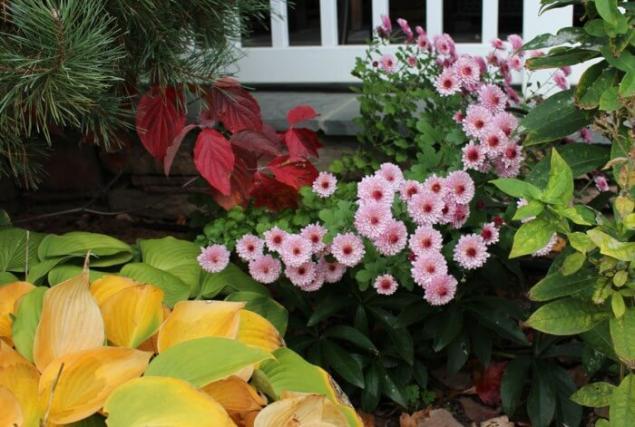
Reproduction by seeds.
Engaged in seed multiplication of Korean chrysanthemums, you should know that this type of reproduction gives shape less resistant to low temperatures and other features of the climate of a particular region. In addition, it should be apparent that a suitable hybrid variety will not be able to grow from collected seeds.
In plants, early flowering with a short growing season the seeds have time to Mature. For seeds from late-flowering chrysanthemums will need to transplant them in a heated greenhouse with temperatures around 20 with good ventilation and sufficient lighting. In such conditions, the seeds will ripen in November-December.
Seeds are harvested as they Mature. Collected seed baskets Pozarevac in a warm and well-ventilated area. After two or three weeks they are Packed for storage. Storage conditions – dry and cool room with a temperature of 2-5 C. the shelf Life of seeds chrysanthemum – 2 years.
Seeds are sown in seed boxes with moist soil in early spring. Crops should not be covered with earth, the seeds need to stay in the light, otherwise they will not germinate. If done right, the first seedlings appear in a week.
As soon as weather permits, the seedlings are transferred to the garden. First flowering starts usually in the second year of the life of the plant.
Propagation by cuttings.
The most popular method of propagation of chrysanthemum. This is justified as this method retains all the varietal characteristics. Plants grown from cuttings, safely tolerate the cold, they grow well and bloom magnificently.
The cuttings begin to cut in the spring, when there is stable warm weather. The selected plant should have a height of at least 20 cm From the tops of young shoots are cut into cuttings with a length of about 10 cm, remove the lower leaves, then stick them in a box with moist soil, which should be moved to the street, protected from rain and wind place. In two weeks, when the cuttings are rooted, transplant the cuttings to a permanent place.

Partners in the flowerbed.
Chrysanthemums go well with salviani (sages). So, sage with blue flowers would be appropriate with yellow and bronze chrysanthemums and pale pink Salvia enhance color perception of red chrysanthemums. Effectively a combination of chrysanthemum plants that do not bloom, as well as with ornamental grasses and cereals. Near the chrysanthemums can be planted variegated plants, such as Coleus. Well they will look with autumn cosmos. A rich palette of Korean chrysanthemums will allow you to fully enjoy the creative delights of any gardener.
Winter.
Not all species and varieties of chrysanthemums can survive our winter. Heat-loving varieties, which include most are tall chrysanthemums with large flowers, are grown using greenhouse or dig further later in the fall for winter storage. There are different ways of storage.
Method 1.
Dug after flowering shrubs should be a lump of earth, young shoots of renewal should be deleted. Uterine bushes firmly put in wooden boxes and transferred for storage in the bright, cold room with an average temperature of 2-6 C and humidity no more than 80%. If Queen cells a little, they can be put in different containers. Watering during storage should be minimal, earthen may be maintained in a slightly moist condition.
Method 2.
Prepared by the bushes stored in the cellar, where they are transferred before the first frost. They are placed close to each other on the earthen floor. The optimum temperature in the cellar should be 0-4 C.
Chrysanthemums can bloom and summer
Both methods of storage provide early (from February) the germination of plants. For this the bushes selected varieties entered in the room with a temperature of about 15 sprouted in such circumstances, the sprouts are separated from the mother Bush and planted in a separate container. About a month later, you can begin the formation of a Bush, preparing it for planting in the ground. Such sprouting is used when you want to achieve more early flowering chrysanthemums, that is, to shift the timing of flowering in the summer.
Method 3.
Storing the bushes of chrysanthemums in trenches of arbitrary length and width and depth of about 50 cm Bushes fit tightly into the trench, the voids in between the roots filled with earth. So leave them until the first frost, which has a little "grab" plants, it will prevent during storage fungal diseases.
At the onset of cold trench shelter material, which will create a frame "roof" of the trench, and poured on top a thick layer of dry leaves sprinkled the ground or put any covering material, which must be fixed reliably. It should be understood that while this method of storage is difficult to monitor the status of wintering plants.
Method 4.
This storage method refers to the Korean chrysanthemums, early flowering and has medium-sized flowers, that is, those plants which are resistant to low temperatures. However, to avoid the risk, should they prepare for the winter. For this chrysanthemums should be cut at a distance of 10 cm from the soil surface and mulch with peat layer of about 10-15 cm

Chrysanthemum annuals.
All the annual chrysanthemums cold, they bloom late into the fall without fear of frost. It is drought-resistant and light-loving plants. They prefer fertile soil without excess of organic fertilizers, well respond to fertilizing with mineral fertilizers. Annual chrysanthemums can be sown in the spring directly into the ground. If you sow the seeds for seedlings in early April, mums will enjoy their blooms a month earlier.
Canadian greenhouse that does not require heating
How to cover roses for the winter
Most common are the following types of chrysanthemums:
All the annual chrysanthemums are undemanding and undemanding to growing conditions. Cut flowers keep their freshness in water and very effective in autumn bouquets.published
Source: www.tomat-pomidor.com/2013/07/%D1%85%D1%80%D0%B8%D0%B7%D0%B0%D0%BD%D1%82%D0%B5%D0%BC%D1%8B/
Flowering chrysanthemums – a real decoration of our gardens in autumn. This bright and generous gift of nature with sagebrush tart flavor like sent us to extend summer days...
History and types of chrysanthemums.
The birthplace of chrysanthemums is Asia. In Europe chrysanthemums was in the middle of the 18th century, but their activity is spread across the continent began almost a century later – in the early 19th century. In Russia, production of ornamental plants began in the 40-50-ies of the last century.
There is a perception that the diversity of chrysanthemum called the "garden" or Chrysanthemum hortorum occurred by crossing two species native to China and Japan – chrysanthemum grandiflorum or Chrys. morifoolium and small-flowered chrysanthemum, or Chrys. indicum.
Chrysanthemum in a biological concept is a genus of annual and perennial herbaceous plants of the family Compositae or Asteraceae, with up to 29 species and grows not only in Asia, but in temperate and Northern latitudes of the globe.

Perennial chrysanthemums.
Among small-flowered chrysanthemums isolated group of so-called Korean chrysanthemums or Ch. coreanum, install a separate species which have not yet succeeded. It is also unclear of their origin, therefore, the definition of "Korean" should be considered conditional. In Amateur gardening this kind of chrysanthemum the most popular, that Korean chrysanthemums decorate gardens in many suburban areas.
Korean chrysanthemum is relatively resistant to low temperatures, this feature allows the winter most varieties of chrysanthemums outdoors in regions with cold winters. In addition, these flowers are famous for abundant flowering and therefore are widely used in ornamental horticulture.
What are and when to bloom?
Varieties of Korean chrysanthemums are very different according to various criteria: time of flowering, shrub height, size of blooms, color and structure of flowers. Conventionally, this kind of chrysanthemums can be divided several groups:
- curb height more than 30 cm, they have early-flowering, dense shrub, give a slight root growth;
- medium height 30-50 cm, are of a great variety of colors and the structure of the flowers.
- tall chrysanthemum has a height of one meter, they have a large and branching shrub with large flowers that have a late flowering period.

The choice of location, soil, planting.
Good growth and abundant flowering chrysanthemums are only possible when a properly sized place for them in the garden, which is well illuminated by the sun at least five hours a day. It is unacceptable to plant them in damp places with stagnant water or in the shade.
Soil.
The soil should be loose, breathable, humus-rich neutral or slightly acid pH. You should not plant chrysanthemums in overly fertilized soil to eliminate the "fattening" of plants at the expense of flowering. Very responsive chrysanthemums on mulching "tree trunks" of the circle.
When to plant?..
To plant chrysanthemums is preferable in spring than in autumn. Disturbed in autumn the plants usually do not tolerate the winter and can die. Also, do not plant flowers in a flourishing condition, therefore, if the planting material is purchased in autumn, it is better not to leave it outdoors and indoors for winter storage (winter storage conditions described below). The scheme of planting — approximately 30x30 cm, spreading bushes – 40x40 cm.

Care and forming bushes.
Chrysanthemums grow very fast. Within one season, small stalk can turn into developed shrub and give abundant blooms. Therefore, special attention should be paid to fertilizing. The first dressing is done with nitrogen fertilizer in the initial growth stage of the shoots, the next one two weeks later, mullein or bird droppings. In the phase of Bud formation necessary dressing of phosphate and potash fertilizers.
To the Bush of chrysanthemum had a beautiful shape and bloomed profusely, it should be formed. To do this, from the beginning of June starts to do a regular pinching of the shoot tips. A month before the beginning of flowering make the last pinching.
In one place chrysanthemums growing no more than three years, or once every three years, in the spring the bushes should be divided. In the first year at the beginning of the growing season, conduct frequent cultivation that contribute to the development of the root system and the growth of underground shoots forming shrub. Further loosening stop for fear of damaging the regrown shoots.
At the end of the growing season, after the first frost for overwintering chrysanthemums should be cut off and Spud. In the approach of steady frosts, the bushes are loose, so they will not Sapeli, covered with spruce branches, branches or other material that delays the snow.
In early spring the bushes freed from the twigs, and as soon as the shoots grow back, remove the old stems and twisting out of the land of Central escape.
Reproduction.

Reproduction by seeds.
Engaged in seed multiplication of Korean chrysanthemums, you should know that this type of reproduction gives shape less resistant to low temperatures and other features of the climate of a particular region. In addition, it should be apparent that a suitable hybrid variety will not be able to grow from collected seeds.
In plants, early flowering with a short growing season the seeds have time to Mature. For seeds from late-flowering chrysanthemums will need to transplant them in a heated greenhouse with temperatures around 20 with good ventilation and sufficient lighting. In such conditions, the seeds will ripen in November-December.
Seeds are harvested as they Mature. Collected seed baskets Pozarevac in a warm and well-ventilated area. After two or three weeks they are Packed for storage. Storage conditions – dry and cool room with a temperature of 2-5 C. the shelf Life of seeds chrysanthemum – 2 years.
Seeds are sown in seed boxes with moist soil in early spring. Crops should not be covered with earth, the seeds need to stay in the light, otherwise they will not germinate. If done right, the first seedlings appear in a week.
As soon as weather permits, the seedlings are transferred to the garden. First flowering starts usually in the second year of the life of the plant.
Propagation by cuttings.
The most popular method of propagation of chrysanthemum. This is justified as this method retains all the varietal characteristics. Plants grown from cuttings, safely tolerate the cold, they grow well and bloom magnificently.
The cuttings begin to cut in the spring, when there is stable warm weather. The selected plant should have a height of at least 20 cm From the tops of young shoots are cut into cuttings with a length of about 10 cm, remove the lower leaves, then stick them in a box with moist soil, which should be moved to the street, protected from rain and wind place. In two weeks, when the cuttings are rooted, transplant the cuttings to a permanent place.

Partners in the flowerbed.
Chrysanthemums go well with salviani (sages). So, sage with blue flowers would be appropriate with yellow and bronze chrysanthemums and pale pink Salvia enhance color perception of red chrysanthemums. Effectively a combination of chrysanthemum plants that do not bloom, as well as with ornamental grasses and cereals. Near the chrysanthemums can be planted variegated plants, such as Coleus. Well they will look with autumn cosmos. A rich palette of Korean chrysanthemums will allow you to fully enjoy the creative delights of any gardener.
Winter.
Not all species and varieties of chrysanthemums can survive our winter. Heat-loving varieties, which include most are tall chrysanthemums with large flowers, are grown using greenhouse or dig further later in the fall for winter storage. There are different ways of storage.
Method 1.
Dug after flowering shrubs should be a lump of earth, young shoots of renewal should be deleted. Uterine bushes firmly put in wooden boxes and transferred for storage in the bright, cold room with an average temperature of 2-6 C and humidity no more than 80%. If Queen cells a little, they can be put in different containers. Watering during storage should be minimal, earthen may be maintained in a slightly moist condition.
Method 2.
Prepared by the bushes stored in the cellar, where they are transferred before the first frost. They are placed close to each other on the earthen floor. The optimum temperature in the cellar should be 0-4 C.
Chrysanthemums can bloom and summer
Both methods of storage provide early (from February) the germination of plants. For this the bushes selected varieties entered in the room with a temperature of about 15 sprouted in such circumstances, the sprouts are separated from the mother Bush and planted in a separate container. About a month later, you can begin the formation of a Bush, preparing it for planting in the ground. Such sprouting is used when you want to achieve more early flowering chrysanthemums, that is, to shift the timing of flowering in the summer.
Method 3.
Storing the bushes of chrysanthemums in trenches of arbitrary length and width and depth of about 50 cm Bushes fit tightly into the trench, the voids in between the roots filled with earth. So leave them until the first frost, which has a little "grab" plants, it will prevent during storage fungal diseases.
At the onset of cold trench shelter material, which will create a frame "roof" of the trench, and poured on top a thick layer of dry leaves sprinkled the ground or put any covering material, which must be fixed reliably. It should be understood that while this method of storage is difficult to monitor the status of wintering plants.
Method 4.
This storage method refers to the Korean chrysanthemums, early flowering and has medium-sized flowers, that is, those plants which are resistant to low temperatures. However, to avoid the risk, should they prepare for the winter. For this chrysanthemums should be cut at a distance of 10 cm from the soil surface and mulch with peat layer of about 10-15 cm

Chrysanthemum annuals.
All the annual chrysanthemums cold, they bloom late into the fall without fear of frost. It is drought-resistant and light-loving plants. They prefer fertile soil without excess of organic fertilizers, well respond to fertilizing with mineral fertilizers. Annual chrysanthemums can be sown in the spring directly into the ground. If you sow the seeds for seedlings in early April, mums will enjoy their blooms a month earlier.
Canadian greenhouse that does not require heating
How to cover roses for the winter
Most common are the following types of chrysanthemums:
- chrysanthemum keeled, it is a powerful plant up to 80 cm and large flowers, flowering begins in early August;
- chrysanthemum crop, has a height of 40-60 cm and large inflorescences, the flowering – the first half of August;
- chrysanthemum Winata, Bush height up to one meter, inflorescence is medium in size simple and double, blooming the end of July–beginning of August;
- chrysanthemum marsh, low plant, a Bush form spherical, the flowers are small, abundant flowering starts from late June;
- chrysanthemum bahatostebelni, height 15-25 cm, small flowers, start flowering the end of June – beginning of July.
All the annual chrysanthemums are undemanding and undemanding to growing conditions. Cut flowers keep their freshness in water and very effective in autumn bouquets.published
Source: www.tomat-pomidor.com/2013/07/%D1%85%D1%80%D0%B8%D0%B7%D0%B0%D0%BD%D1%82%D0%B5%D0%BC%D1%8B/
Emotional intelligence: key considerations for development
Biodegradable furniture and carpets from the "Forest of fur"



